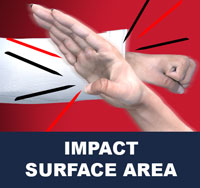|
Surface |
Korean |
Description |
Tutorial |
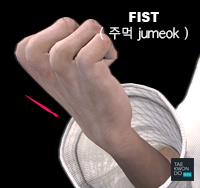 |
Fist
( 주먹 jumeok ) |
주먹 jumeok |
A fist ( 주먹 jumeok ) is an action where a hand has the fingers curled into the palm and the thumb retracted, displaying the knuckles. The act of creating a fist is known as 'making a fist' or 'clenching a fist'. |
|
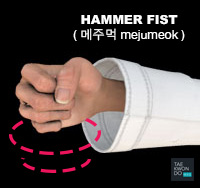 |
Hammer Fist
( 메주먹 mejumeok ) |
메주먹 mejumeok |
A Hammer Fist ( 메주먹 mejumeok ) is an action where a hand has the fingers curled into the palm and the thumb retracted, using the bottom of the hand as the striking surface. The act of creating a fist ( 주먹 jumeok ) is known as 'making a fist' or 'clenching a fist'. |
|
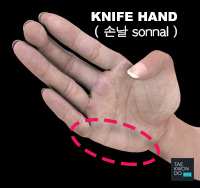 |
Hand Blade
( 손날 sonnal ) |
손날 sonnal |
By tucking the thumb into the palm, a striking surface called the knife hand or hand blade ( 손날 sonnal ) is formed. The striking surface extends with the muscle at the side of the hand located between the base of the small finger and the wrist (abductor digiti minimi). |
|
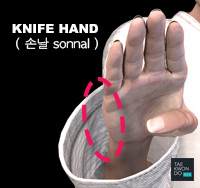 |
Knife Hand
( 손날 sonnal ) |
손날 sonnal |
By tucking the thumb into the palm, a striking surface called the knife hand or hand blade ( 손날 sonnal ) is formed. The striking surface extends with the muscle at the side of the hand located between the base of the small finger and the wrist (abductor digiti minimi). |
|
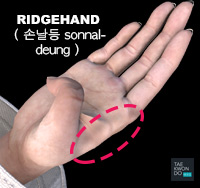 |
Ridgehand
( 손날등 sonnal-deung ) |
손날등 sonnal-deung |
By tucking the thumb into the palm, a striking surface called the ridgehand ( 손날등 sonnal-deung ), or reverse knife-hand is formed, extending a few inches along the inside of the hand below the first knuckle of the index finger. |
|
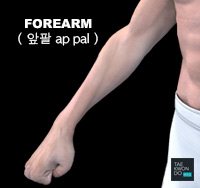 |
Forearm
( 앞팔 ap-pal ) |
앞팔 ap-pal |
The forearm ( 앞팔 ap-pal ) is the region of the upper limb between the elbow and the wrist. The forearm ( 앞팔 ap-pal ) is used primarily as a defensive surface in taekwondo, which can be executed as a high, low, middle, side, inward, or outward. |
|
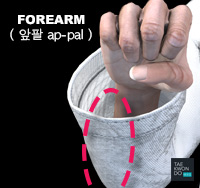 |
Forearm
( 앞팔 ap-pal ) |
앞팔 ap-pal |
The forearm ( 앞팔 ap-pal ) is the region of the upper limb between the elbow and the wrist. The forearm ( 앞팔 ap-pal ) is used primarily as a defensive surface in taekwondo, which can be executed as a high, low, middle, side, inward, or outward. |
|
 |
Inner Wrist
( 안팔목 anpalmok ) |
안팔목 anpalmok |
The Inner Wrist ( 안팔목 anpalmok ) is the area between the wrist bone and the lower part of the inner forearm. The wrist must be kept straight in proper alignment during the posture. If the wrist bends on impact, it can easily be sprained, dislocated or broken. |
|
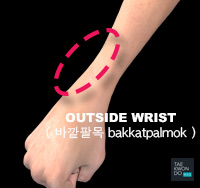 |
Outside Wrist
( 바깥팔목 bakkatpalmok ) |
바깥팔목 bakkatpalmok |
The Outside Wrist ( 바깥팔목 bakkatpalmok ) is the area between the wrist bone and the lower part of the outer forearm. The wrist must also be kept straight in proper alignment during the posture. If the wrist bends on impact, it can easily be sprained, dislocated or broken. |
|
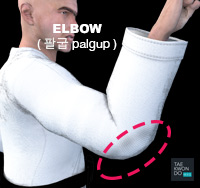 |
Elbow
( 팔굽 palgup ) |
팔굽 palgup |
The elbow is the visible joint between the upper and lower parts of the arm. The function of the elbow joint is to extend and flex the arm grasp and reach for objects. |
|
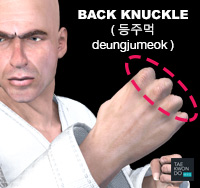 |
Back Knuckle
( 등주먹 deung-jumeok ) |
등주먹 deung-jumeok |
The knuckles are the joints of the fingers. Back Knuckle is the area between the back of the hand and the joints of the fingers. |
|
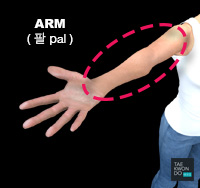 |
Arm
( 팔 pal ) |
팔 pal |
The arm ( 팔 pal ) is the part that extends from the shoulder joint to the hands. It can be divided into the upper arm, which extends from the shoulder to the elbow, or the forearm which extends from the elbow to the hand. |
|
 |
Hand
( 손 son ) |
손 son |
Hand is located at the end of the forearm which normally has five digits: four fingers plus one thumb; these are often referred to collectively as five fingers, however, whereby the thumb is included as one of the fingers. |
|
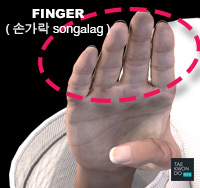 |
Finger
( 손가락 songalag ) |
손가락 songalag |
A finger is a limb of the human body and a type of digit, an organ of manipulation and sensation found in the hands of humans. The first digit is the thumb, followed by index finger, middle finger, ring finger, and little finger or pinkie. According to different definitions, the thumb can be called a finger, or not. |
|
 |
Palm
( 손바닥 sonbadak ) |
손바닥 sonbadak |
Palm is the central region of the anterior part of the hand. The four fingers can be folded over the palm which allows the grasping of objects. |
|
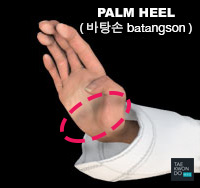 |
Palm Heel
( 바탕손 batangson ) |
바탕손 batangson |
The heel of the hand is the area anteriorly to the bases of the metacarpal bones, located in the proximal part of the palm. It is the area that sustains most pressure when using the palm of the hand for support, such as in handstand. |
|
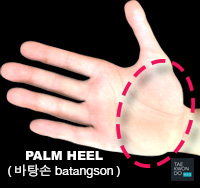 |
Palm Heel
( 바탕손 batangson ) |
바탕손 batangson |
The heel of the hand is the area anteriorly to the bases of the metacarpal bones, located in the proximal part of the palm. It is the area that sustains most pressure when using the palm of the hand for support, such as in handstand. |
|
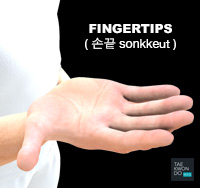 |
Fingertips
( 손끝 sonkkeut ) |
손끝 sonkkeut |
The fingertips possess the highest concentration of touch receptors and thermoreceptors among all areas of the human skin, making them extremely sensitive to temperature, pressure, vibration, texture and moisture. |
|
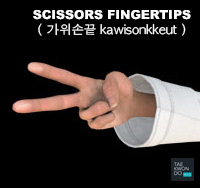 |
Scissors Fingertips
( 가위손끝 kawisonkkeut ) |
가위손끝 kawisonkkeut |
A finger is a limb of the human body and the fingertip is the edge of the finger. The Scissors Fingertips ( 가위손끝 kawisonkkeut ) form the shape of a scissor with the index and middle fingers. |
|
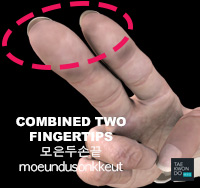 |
Combined Two Fingertips
( 모은두손끝 moeundusonkkeut ) |
모은두손끝 moeundusonkkeut |
A finger is a limb of the human body and the fingertip is the edge of the finger. The Combined Two Fingertips ( 모은두손끝 moeundusonkkeut ) is formed with the index and middle fingers together to create a striking surface. The thumb touches the ring finger and little finger to strengthen the posture. |
|
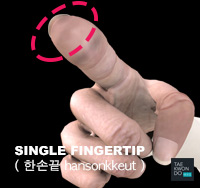 |
Single Fingertip
( 한손끝 hansonkkeut ) |
한손끝 hansonkkeut |
A finger is a limb of the human body and the fingertip is the edge of the finger. The Single Fingertip ( 한손끝 hansonkkeut ) is formed with the index finger as the striking surface. The thumb touches the ring finger and middle finger to strengthen the posture. |
|
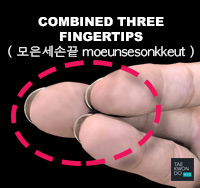 |
Combined Three Fingertips
( 모은세손끝 moeunsesonkkeut ) |
모은세손끝 moeunsesonkkeut |
A finger is a limb of the human body and the fingertip is the edge of the finger. The Combined Three Fingertips ( 모은세손끝 moeunsesonkkeut ) is formed with the index, middle, and ring finger as the striking surface. The thumb touches the little finger to strengthen the posture. |
|
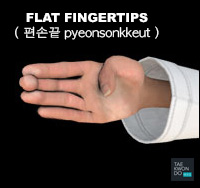 |
Flat Fingertips
( 편손끝 pyeonsonkkeut ) |
편손끝 pyeonsonkkeut |
A finger is a limb of the human body and the fingertip is the edge of the finger. Flat Fingertips ( 편손끝 pyeonsonkkeut ) is formed with the index, middle, ring, and little finger as the striking surface. The middle finger is lowered slightly to line up with the index and ring fingers to create a combined striking surface. |
|
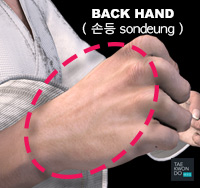 |
Back Hand
( 손등 sondeung ) |
손등 sondeung |
The back side of the hand which is located at the end of the forearm which normally has five digits: four fingers plus one thumb; these are often referred to collectively as five fingers, however, whereby the thumb is included as one of the fingers. |
|
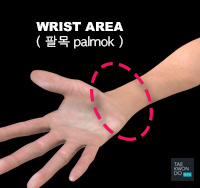 |
Wrist Area
( 팔목 palmok ) |
팔목 palmok |
The Wrist Area ( 팔목 palmok ) is the wrist joint or radiocarpal joint, the joint between the radius and the carpus and the anatomical region surrounding the carpus including the distal parts of the bones of the forearm and the proximal parts of the metacarpus or five metacarpal bones and the series of joints between these bones, thus referred to as wrist joints. |
|
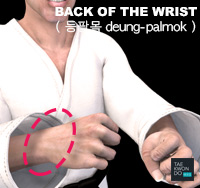 |
Back of the Wrist
( 등팔목 deung-palmok ) |
등팔목 deung-palmok |
The Back of the Wrist ( 등팔목 deung-palmok ) is the back area of the wrist between the hand and the forearm. |
|
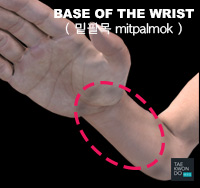 |
Base of the Wrist or Inner Wrist
( 밑팔목 mitpalmok ) |
밑팔목 mitpalmok |
The Base of the Wrist or Inner Wrist ( 밑팔목 mitpalmok ) is the area slightly below the wrist area ( 팔목 palmok ). |
|
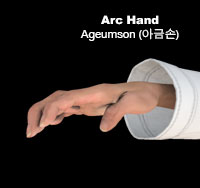 |
Arc Hand
( 아금손 ageumson ) |
아금손 ageumson |
|
|
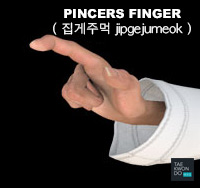 |
Pincers Finger
( 집게주먹 jipgejumeok ) |
집게주먹 jipgejumeok |
The fist is closed except for the thumb and forefinger which are fully extended outwards to grab most commonly the opponents throat. |
|
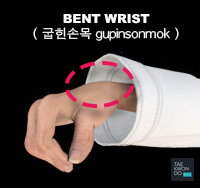 |
Bent Wrist
( 굽힌손목 gupinsonmok ) |
굽힌손목 gupinsonmok |
Fingers all touch together at the tip and bend the wrist ( 팔목 palmok ) slightly exposing the top area which is called the bent wrist ( 굽힌손목 gupinsonmok ) |
|
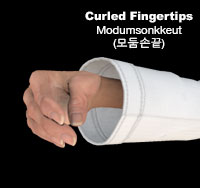 |
Curled Fingertips
( 모둠손끝 modumsonkkeut ) |
모둠손끝 modumsonkkeut |
|
|
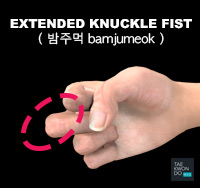 |
Extended Knuckle Fist
( 밤주먹 bamjumeok ) |
밤주먹 bamjumeok |
One of the fingers most commonly the middle finger is moved forwards so that the impact is made with the knuckle, concentrating force onto a smaller area such as the eyes, temple or sternum area. The knuckles are the joints of the fingers. |
|
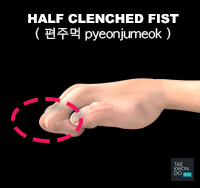 |
Half-clenched Fist
( 편주먹 pyeonjumeok ) |
편주먹 pyeonjumeok |
|
|
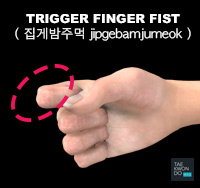 |
Trigger Finger Fist
( 집게밤주먹 jipgebamjumeok ) |
집게밤주먹 jipgebamjumeok |
|
|
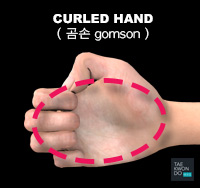 |
Curled Hand
( 곰손 gomson ) |
곰손 gomson |
|
|
|
Surface |
Korean |
Description |
Tutorial |
 |
Foot
( 발 bal ) |
발 bal |
The human foot is a strong and complex mechanical structure containing 26 bones, 33 joints, and more than a hundred muscles, tendons, and ligaments. The human foot has two longitudinal arches and a transverse arch maintained by the interlocking shapes of the foot bones, strong ligaments, and pulling muscles during activity. |
|
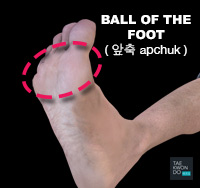 |
Ball of the Foot
( 앞축 apchuk ) |
앞축 apchuk |
The ball of the foot is the padded portion of the sole between the toes and the arch, underneath the heads of the metatarsal bones. To strike with the ball of the foot ( 앞축 apchuk ), one has to raise one's toes so that the toe tips will not be the first contact point. |
|
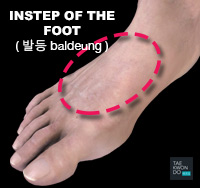 |
Instep of the Foot
( 발등 baldeung ) |
발등 baldeung |
Practitioner can perform a kick with the flat upperside or to be specific, the instep of the foot. The instep is the arched part of the top of the foot between the toes and the ankle. |
|
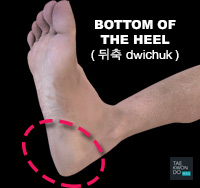 |
Bottom of the Heel
( 뒤축 dwichuk ) |
뒤축 dwichuk |
The heel is the prominence at the posterior end of the foot. It is based on the projection of one bone, the calcaneus or heel bone, behind the articulation of the bones of the lower leg. |
|
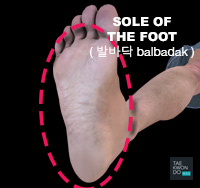 |
Sole of the Foot
( 발바닥 balbadak ) |
발바닥 balbadak |
The sole is the bottom of the foot. The sole contains the thickest layers of skin on the body due to the weight that is continually placed on it. It is crossed by a set of creases that form during the early stages of embryonic development. |
|
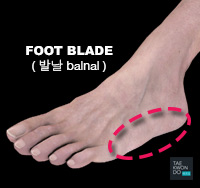 |
Foot Blade
( 발날 balnal ) |
발날 balnal |
The Foot Blade ( 발날 balnal ) is the outside edge of the foot which forms a blade. The striking surface extends from the outside edge of the heel up to the base of the small toe. Strikes should channel force through a small area of the attacker's body. |
|
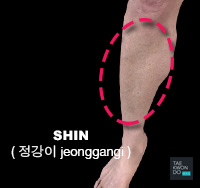 |
Shin
( 정강이 jeonggangi ) |
정강이 jeonggangi |
The front part of the human leg below the knee. Shinbone is the larger, stronger, and anterior (frontal) of the two bones in the leg below the knee in vertebrates, and it connects the knee with the ankle bones. The leg bones are the strongest long bones as they support the rest of the body. |
|
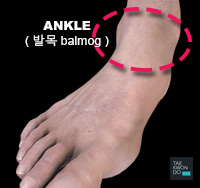 |
Ankle
( 발목 balmog ) |
발목 balmog |
Ankle is the region where the foot and the leg meet. As a region, the ankle is found at the junction of the leg and the foot. It extends downwards (distally) from the narrowest point of the lower leg and includes the parts of the foot closer to the body (proximal) to the heel and upper surface (dorsum) of the foot. |
|
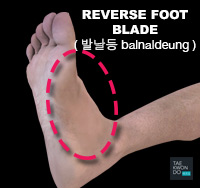 |
Reverse Foot Blade
( 발날등 balnaldeung ) |
발날등 balnaldeung |
Reverse Foot Blade ( 발날등 balnaldeung ) is the inside edge of the foot. The striking surface extends from the inside edge of the heel up to the base of the big toe. Strikes should channel force through a small area of the attacker's body. |
|
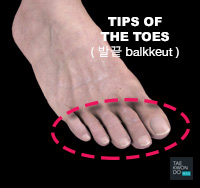 |
Tips of the Toes
( 발끝 balkkeut ) |
발끝 balkkeut |
There are five toes present on each human foot. The human foot consists of multiple bones and soft tissues which support the weight of the upright human. Specifically, the toes assist the human while walking, providing balance, weight-bearing, and thrust during gait. |
|
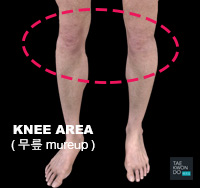 |
Knee
( 무릎 mureup ) |
무릎 mureup |
The knee joins the thigh with the leg. The knee is a modified hinge joint, which permits flexion and extension as well as slight internal and external rotation. The knee is vulnerable to injury and to the development of osteoarthritis. The knee is the largest joint and one of the most important joints in the body. |
|
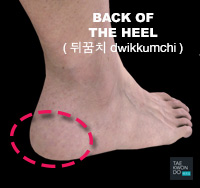 |
Back of the Heel
( 뒤꿈치 dwikkumchi ) |
뒤꿈치 dwikkumchi |
The Back of the Heel ( 뒤꿈치 dwikkumchi ) is the surface between the Bottom of the Heel ( 뒤축 dwichuk ) and the base area of the ankle in the back. It is based on the projection of one bone, the calcaneus or heel bone, behind the articulation of the bones of the lower leg. |
|
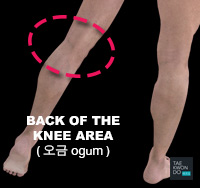 |
Back of the Knee
( 오금 ogum ) |
오금 ogum |
The area opposite of the knee or to be precise, the back of the knee is called ( 오금 ogum ). This area is particularly weak, since attacking leg muscles will often cripple an opponent's mobility. |
|
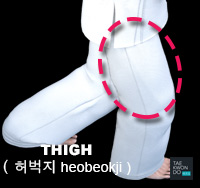 |
Thigh
( 허벅지 heobeokji ) |
허벅지 heobeokji |
The thigh ( 허벅지 heobeokji ) is the area between the hip (pelvis) and the knee. Anatomically, it is part of the lower limb. The single bone in the thigh is called the femur. This bone is very thick and strong (due to the high proportion of bone tissue), and forms a ball and socket joint at the hip, and a modified hinge joint at the knee. |
|
|
Surface |
Korean |
Description |
Tutorial |
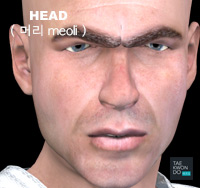 |
Head
( 머리 meoli ) |
머리 meoli |
In human anatomy, the head is at the top of the human body. It supports the face and is maintained by the skull, which itself encloses the brain. On either side of the mouth, the cheeks provide a fleshy border to the oral cavity. The ears sit to either side of the head. |
|
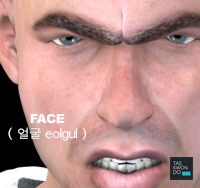 |
Face
( 얼굴 eolgul ) |
얼굴 eolgul |
The face is the anterior part of the head, containing the eyes, nose, and mouth. The face is itself a highly sensitive region of the human body and its expression may change when the brain is stimulated by any of the many human senses, such as touch, temperature, smell, taste, hearing, movement, hunger, or visual stimuli. |
|
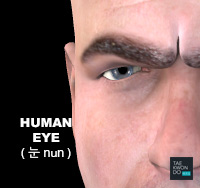 |
Human Eye
( 눈 nun ) |
눈 nun |
The human eye is an organ that reacts to light and allows vision. The human eye can differentiate between about 10 million colors and is possibly capable of detecting a single photon. The eye is part of the sensory nervous system. |
|
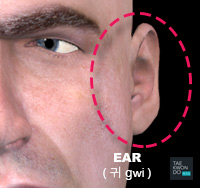 |
Ear
( 귀 gwi ) |
귀 gwi |
The ear is the organ of hearing. Sound waves travel through the outer ear, are modulated by the middle ear, and are transmitted to the vestibulocochlear nerve in the inner ear. This nerve transmits information to the temporal lobe of the brain, where it is registered as sound. |
|
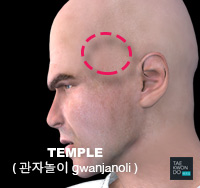 |
Temple
( 관자놀이 gwanjanoli ) |
관자놀이 gwanjanoli |
The temple ( 관자놀이 gwanjanoli ) is a juncture where four skull bones fuse together: the frontal, parietal, temporal, and sphenoid. It is located on the side of the head behind the eye between the forehead and the ear. |
|
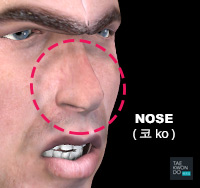 |
Nose
( 코 ko ) |
코 ko |
The human nose is the most protruding part of the face. It bears the nostrils and is the first organ of the respiratory system. The shape of the nose is determined by the nasal bones and the nasal cartilages, including the nasal septum which separates the nostrils and divides the nasal cavity into two. |
|
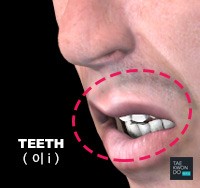 |
Teeth
( 이 i ) |
이 i |
The human teeth function to mechanically break down items of food by cutting and crushing them in preparation for swallowing and digesting. Teeth are made of multiple tissues of varying density and hardness. |
|
 |
Chin
( 턱 teog ) |
턱 teog |
The chin ( 턱 teog ) or the mental region is the area of the face below the lower lip and including the mandibular prominence. It is formed by the lower front of the mandible. |
|
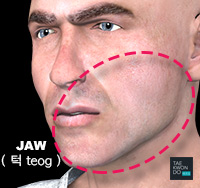 |
Jaw
( 턱 teog ) |
턱 teog |
The jaw is any opposable articulated structure at the entrance of the mouth, typically used for grasping and manipulating food. The term jaws is also broadly applied to the whole of the structures constituting the vault of the mouth and serving to open and close it. |
|
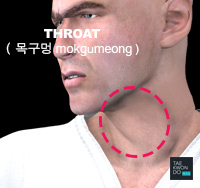 |
Throat
( 목구멍 mokgumeong ) |
목구멍 mokgumeong |
The throat is the front part of the neck, positioned in front of the vertebra. It contains the pharynx and larynx. The throat contains various blood vessels, pharyngeal muscles, the nasopharyngeal tonsil, the tonsils, the palatine uvula, the trachea, the esophagus, and the vocal cords. |
|
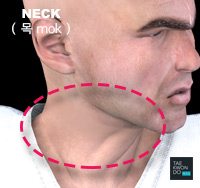 |
Neck
( 목 mok ) |
목 mok |
The neck is the part of the body that separates the head from the torso. The neck supports the weight of the head and protects the nerves that carry sensory and motor information from the brain down to the rest of the body. |
|
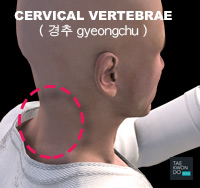 |
Cervical Vertebrae
( 경추 gyeongchu ) |
경추 gyeongchu |
The cervical vertebrae are the vertebrae of the neck immediately below the skull. |
|
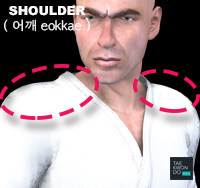 |
Shoulder
( 어깨 eokkae ) |
어깨 eokkae |
The shoulder is made up of three bones: collarbone, shoulder blade, and the upper arm bone as well as associated muscles, ligaments and tendons. It must be mobile enough for the wide range actions of the arms and hands, but stable enough to allow for actions such as lifting, pushing, and pulling. |
|
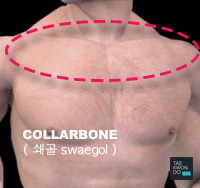 |
Collarbone
( 쇄골 swaegol ) |
쇄골 swaegol |
The collarbone is a long bone that serves as a strut between the shoulder blade and the sternum or breastbone. It can easily be fractured due to impacts to the shoulder from the force of falling on outstretched arms or by a direct hit. |
|
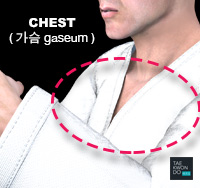 |
Chest
( 가슴 gaseum ) |
가슴 gaseum |
The chest or thorax is a part of the anatomy of humans located between the neck and the abdomen. It contains organs including the heart, lungs, and thymus gland, as well as muscles and various other internal structures. |
|
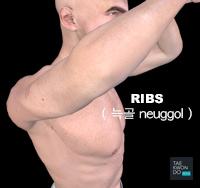 |
Ribs
( 늑골 neuggol ) |
늑골 neuggol |
Ribs are the long curved bones which form the rib cage, part of the axial skeleton. They serve to protect the lungs, heart, and other internal organs of the thorax. Ribs are classed as flat bones which usually have a protective role in the body. |
|
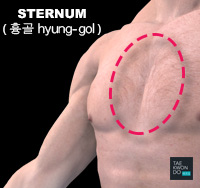 |
Sternum
( 흉골 hyung-gol ) |
흉골 hyung-gol |
The sternum or breastbone is a long flat bone located in the central part of the chest. It connects to the ribs via cartilage and forms the front of the rib cage, thus helping to protect the heart, lungs, and major blood vessels from injury. |
|
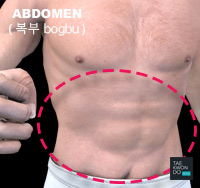 |
Abdomen
( 복부 bogbu ) |
복부 bogbu |
The abdomen (less formally called the belly, tummy or midriff) is the part of the body between the thorax (chest) and pelvis in humans. The abdomen is the front part of the abdominal segment of the trunk. |
|
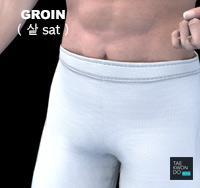 |
Groin
( 샅 sat ) |
샅 sat |
The groin is the junctional area between the abdomen and the thigh on either side of the pubic bone. A pulled groin muscle usually refers to a painful injury sustained by straining the hip adductor muscles. |
|
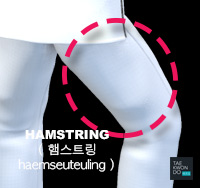 |
Hamstring
( 햄스트링 haemseuteuling ) |
햄스트링 haemseuteuling |
The hamstring ( 햄스트링 haemseuteuling ) is any one of the three posterior thigh muscles in between the hip and the knee. The hamstrings are quite susceptible to injury. |
|
